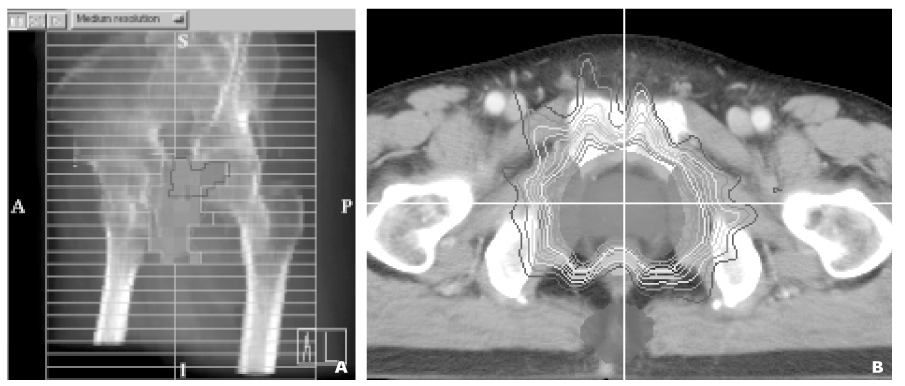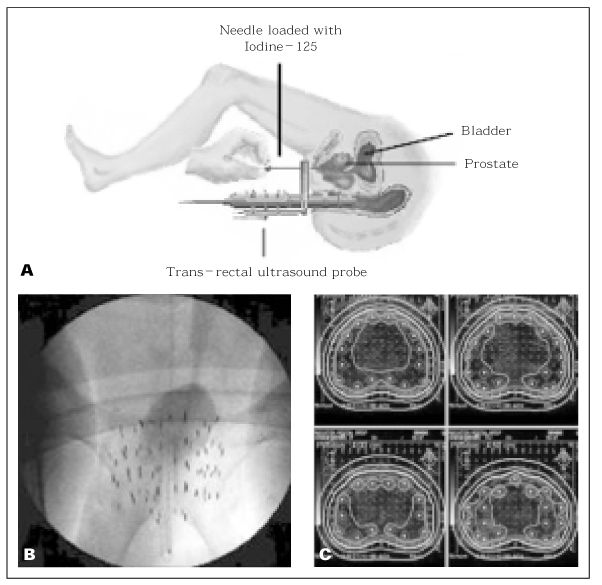J Korean Med Assoc.
2004 May;47(5):424-431. 10.5124/jkma.2004.47.5.424.
Radiation Treatment for Prostate Cancer
- Affiliations
-
- 1Department of Radiation Oncology, Yonsei University College of Medicine, Severance Hospital, Korea. jjhmd@yumc.yonsei.ac.kr
- KMID: 2137877
- DOI: http://doi.org/10.5124/jkma.2004.47.5.424
Abstract
- Selecting the optimal treatment of each stage of prostate cancer is very challenging, partly because the options for treatment today are far better than they were ten years ago, but also because not enough reliable data are available on which to base the decisions. Accordingly, scientifically controlled, long-term studies are still needed to compare the benefits and risks of the various treatments. In the process of counseling and discussing therapeutic options with patients with prostate cancer, it is important to present all available data regarding the variable natural history of this disease, prognostic significance of the diagnosis, potential therapeutic benefit of the various modalities, and immediate as well as late treatment-related sequelae. Radiation therapy can be given either as external beam radiation over perhaps 6 or 7 weeks or as an implant of radioactive seeds (brachytherapy) directly into the prostate. In external beam radiation, high energy x-rays are aimed at the tumor and the area immediately surrounding it. In brachytherapy, radioactive seeds are inserted through needles into the prostate gland under the guidance of transrectally taken ultrasound pictures. This article will describe recent advances in external beam radiotherapy (3D conformal radiotherapy (3D-CRT) and Intensity Modulated Radiotherapy (IMRT)), indications of radiotherapy, response evaluation and assessment of relapse after the radiation treatment for prostate cancer, and radiation-related complications.
Keyword
MeSH Terms
Figure
Cited by 1 articles
-
A Magnetic Resonance-based Seed Localization Method for I-125 Prostate Implants
Rena J. Lee, HyunSuk Suh, Kyung-Ja Lee, Soome Lim, Yookyung Kim, Sungkyu Kim, Jinho Choi
J Korean Med Sci. 2007;22(Suppl):S129-S133. doi: 10.3346/jkms.2007.22.S.S129.
Reference
-
1. Catalona WJ, Basler JW. Return of erections and urinary continence following nerve sparing radical retropubic prostatectomy. J Urol. 1993. 150(3):905–907.
Article2. Eastham JA, Scardino PT. Walsh PC, Retik AB, Vaughan ED, editors. Radical prostatectomy. Campbell's Urology. 8th ed. Philadelphia: WB Saunders;3080–3083.3. Zelefsky MJ, Fuks Z, Hunt M, Lee HJ, Lombardi D, Leibel SA, et al. High dose radiation delivered by intensity modulated conformal radiotherapy improves the outcome of localized prostate cancer. J Urol. 2001. 166:878–881.
Article4. Zelefsky MJ, Fuks Z, Happersett L, Lee HJ, Ling CC, Leibel SA, et al. Clinical experience with intensity modulated radiation therapy (IMRT) in prostate cancer. Radiother Oncol. 2000. 55(3):241–249.
Article5. Consensus conference. The management of clinically localized prostate cancer. JAMA. 1987. 258(19):2727–2730.6. Epstein JI, Paull G, Eggleston JC, Walsh PC. Prognosis of untreated stage A1 prostatic carcinoma: a study of 94 cases with extended followup. J Urol. 1986. 136(4):837–839.
Article7. D'Amico AV, Whittington R, Kaplan I, Beard C, Schultz D, Coleman CN, et al. Equivalent 5-year bNED in select prostate cancer patients managed with surgery or radiation therapy despite exclusion of the seminal vesicles from the CTV. Int J Radiat Oncol Biol Phys. 1997. 39(2):335–340.8. Kupelian P, Katcher J, Levin H, Zippe C, Suh J, Klein E, et al. External beam radiotherapy versus radical prostatectomy for clinical stage T1-2 prostate cancer:therapeutic implications of stratification by pretreatment PSA levels and biopsy Gleason scores. Cancer J Sci Am. 1997. 3(2):78–87.9. Zelefsky MJ, Wallner KE, Ling CC, Raben A, Hollister T, Leibel SA, et al. Comparison of the 5-year outcome and morbidity of three-dimensional conformal radiotherapy versus transperineal permanent iodine-125 implantation for early-stage prostatic cancer. J Clin Oncol. 1999. 17(2):517–522.
Article10. Adolfsson J, Steineck G, Whitmore WF Jr. Recent results of management of palpable clinically localized prostate cancer. Cancer. 1993. 72(2):310–322.
Article11. Peschel RE, Colberg JW. Surgery, brachytherapy, and external-beam radiotherapy for early prostate cancer. Lancet Oncol. 2003. 4(4):233–241.
Article12. Catalona WJ, Smith DS. 5-year tumor recurrence rates after anatomical radical retropubic prostatectomy for prostate cancer. J Urol. 1994. 152(5 Pt 2):1837–1842.
Article13. Gibbons RP. Total prostatectomy for clinically localized prostate cancer: long-term surgical results and current morbidity. NCI Monogr. 1988. (7):123–126.14. Babaian RJ, Zagars GK, Ayala AG. Radiation therapy of stage C prostate cancer: significance of Gleason grade to survival. Semin Urol. 1990. 8(4):225–231.15. del Regato JA, Trailins AH, Pittman DD. Twenty years follow-up of patients with inoperable cancer of the prostate (stage C) treated by radiotherapy: report of a national cooperative study. Int J Radiat Oncol Biol Phys. 1993. 26(2):197–201.
Article16. Pilepich MV, Winter K, John MJ, Mesic JB, Sause W, Grignon D, et al. Phase III radiation therapy oncology group (RTOG) trial 86-10 of androgen deprivation adjuvant to definitive radiotherapy in locally advanced carcinoma of the prostate. Int J Radiat Oncol Biol Phys. 2001. 50(5):1243–1252.
Article17. Consensus statement: guidelines for PSA following radiation therapy. American Society for Therapeutic Radiology and Oncology Consensus Panel. Int J Radiat Oncol Biol Phys. 1997. 37(5):1035–1041.18. Ritter MA, Messing EM, Shanahan TG, Potts S, Chappell RJ, Kinsella TJ. Prostate-specific antigen as a predictor of radiotherapy response and patterns of failure in localized prostate cancer. J Clin Oncol. 1992. 10(8):1208–1217.
Article19. Zagars GK, Sherman NE, Babaian RJ. Prostate-specific antigen and external beam radiation therapy in prostate cancer. Cancer. 1991. 67(2):412–420.
Article20. Critz FA, Williams WH, Holladay CT, Levinson AK, Benton JB, Shrake PD, et al. Post-treatment PSA < or = 0.2 ng/mL defines disease freedom after radiotherapy for prostate cancer using modern techniques. Urology. 1999. 54(6):968–971.
Article21. Hamilton AS, Stanford JL, Gilliland FD, Albertsen PC, Stephenson RA, Potosky AL, et al. Health outcomes after external-beam radiation therapy for clinically localized prostate cancer:results from the Prostate Cancer Outcomes Study. J Clin Oncol. 2001. 19(9):2517–2526.22. Seymore CH, el-Mahdi AM, Schellhammer PF. The effect of prior transurethral resection of the prostate on post radiation urethral strictures and bladder neck contractures. Int J Radiat Oncol Biol Phys. 1986. 12(9):1597–1600.
Article
- Full Text Links
- Actions
-
Cited
- CITED
-
- Close
- Share
- Similar articles
-
- Change of serum prostate specific antigen values after radiation therapy in prostate cancer
- Rationale of Surgery in Locally Advanced and Oligometastatic Prostate Cancer
- Application of Intensity Modulated Radiation Therapy (IMRT) in Prostate Cancer
- Third-generation Cryosurgery for Prostate Cancer Patient with a Penile Prosthesis
- Radiotherapy in prostate cancer treatment: results of the patterns of care study in Korea




